The critical role that interconnection plays in enabling the clean energy transition is why the U.S. Department of Energy established i2x to identify and develop solutions that make interconnection fairer, faster, and simpler.
Interconnection Innovation e-Xchange
May 11, 2023
Every state has different policies that control how clean energy generation is connected to transmission networks like this one.
Proposed renewable generation and energy storage projects face lengthy delays and high costs to interconnect them to the transmission grid. Without reforms, interconnection is likely to remain a major obstacle to meeting clean energy deployment and decarbonization goals. The critical role that interconnection plays in enabling the clean energy transition is why the U.S. Department of Energy established the Interconnection Innovation Exchange (i2X) to identify and develop solutions that make interconnection fairer, faster, and simpler.
Recent reports released by the Lawrence Berkeley National Laboratory (LBNL) highlight how high interconnection costs—which refer to the costs associated with interconnecting an energy generator or storage project to the grid, including funding at the point of interconnection and any broader network upgrades needed to accommodate the addition of the new project’s capacity—are impacting deployment of renewables and storage in the United States’ two largest independent system operator (ISO) and regional transmission operator (RTO) territories. The two ISO/RTOs, PJM and the Midcontinent Independent System Operator (MISO), operate wholesale power systems that serve a combined 110 million people across the eastern and midwestern United States. These two LBNL reports are part of a series that examine costs in five ISO/RTOs.
The reports show that transmission interconnection costs have doubled for both PJM and MISO in recent years. According to the reports, proposed renewable energy and energy storage projects in both ISO/RTOs’ interconnection queues face significantly greater interconnection costs than natural gas generators.
Clean Energy Goals Depend on Interconnection
Rising interconnection costs and long queue delays for renewables may impede clean energy goals set at the federal and state level. The administration has a goal of a carbon-free electric grid by 2035, which will require a large deployment of new renewable energy generation and storage capacity. 31 states and Washington, DC have currently also adopted renewable portfolio standard (RPS) policies, which set binding targets that require that a portion of electricity generation in each state come from renewable or “clean” sources.
Several states served by PJM or MISO have ambitious clean energy goals, with four states in MISO territory (Minnesota, Illinois, Wisconsin, and Michigan) and three in PJM (Maryland, Virginia, and New Jersey) aiming to achieve 100% zero-carbon or net-zero electricity by 2050 or earlier.
Costs Rising as Capacity Waits in Interconnection Queues
While in interconnection queues, proposed generator facilities are studied for their impacts on the transmission grid. In PJM territory, average costs for projects that completed studies between 2020 and 2022 had doubled compared to similar projects between 2017 and 2019. MISO also had a doubling of costs for projects completed between 2019 and 2021 compared to projects from before 2019. These numbers have increased even more for projects that remain in the queue, with MISO seeing costs triple and PJM an extraordinary 800% cost increase for active applications in just the last two years.
In both territories, these large cost increases correspond with a dramatic increase in the number of projects proposed for interconnection. The addition of so much new capacity is straining the transmission system, driving up network upgrade costs while also increasing delays for projects waiting in the queue.
For PJM, the nation’s largest RTO, the total capacity of projects waiting in its interconnection queue nearly quadrupled between 2017 and 2021, to a total of 288 gigawatts (GW)—with approximately another 40 GW added in 2022. Similarly, the capacity in MISO’s interconnection queue nearly tripled between 2017 and 2021. In both queues, the overwhelming majority of applications during those time periods—93% for PJM, and 96% for MISO—were for renewable energy or energy storage projects.

Total Capacity in PJM and MISO Queues by Fuel Type, 2012-2022. Hybrid storage capacity is estimated for some projects.
These unprecedented interconnection cost increases are mostly driven by network upgrade costs. While costs for facilities at the specific point of interconnection are smaller and have remained relatively constant, some projects require broader upgrades to ensure the system can accommodate new generating capacity. These costs vary widely and can be significant.
Proposed wind, solar, and storage projects have paid higher network upgrade costs on average than natural gas projects applying for interconnection to either PJM or MISO’s networks. This may be due to several factors, such as location and technology. Many projects are proposed in places where transmission lines are already near capacity, which can require more to be built to accommodate new generators. In other cases, large wind and solar projects are located far from the population centers they serve, requiring funding for new substations and long-distance transmission lines.


High Interconnection Costs Impose Barriers to New Renewable Energy Projects
When the costs of interconnecting to the grid become high enough to jeopardize the economic feasibility of a project, developers withdraw from the queue. According to LBNL’s studies, projects that withdrew faced much higher interconnection costs than active or completed projects. In PJM’s queue, projects in the queue in 2022 were charged mean interconnection costs of $240/kW of capacity, while projects that withdrew between 2020 and 2022 had mean interconnection costs of $599/kW.
When high network upgrade costs force potential energy generators out of the interconnection queue, those costs are then imposed on other developers—which can lead to a cascade of withdrawals of potential renewable energy projects that then are never built. Project withdrawal numbers are very high: according to the reports, only 24% of all projects in MISO’s queue and 27% in PJM’s queue that applied for interconnection between 2000 and 2016 were in operation by 2021.
Developing Solutions to Interconnection Challenges
PJM and MISO have adopted some reforms to address interconnection costs and improve the speed and efficiency of the interconnection process. Both ISO/RTOs have adopted a clustered “first-ready, first served” approach to interconnection studies, where multiple projects are studied at once and the order is determined by readiness rather than by the order in which developers submitted their applications. MISO also increased proactive funding for new transmission infrastructure to reduce the financial burden on project developers for those network upgrades, while PJM adopted an “expedited” process for projects with low network upgrade costs. Both ISO/RTOs have also begun publishing maps to give developers additional insight on potential costs before they enter the queue.
These reforms, however, have not yet slowed the increase in interconnection costs, and additional improvements are still needed to better enable new clean energy projects to be added to the grid. Some of these steps may include changes to transmission planning to better anticipate where future clean energy projects will be sited and the adoption of new policies and technologies that enable more flexible interconnection, among other proposals. The Interconnection Innovation eXchange, or i2X, is a DOE initiative that convenes diverse stakeholder groups—including utilities, project developers, regulators, and host communities—to develop and test solutions that solve interconnection-related obstacles to a modern, clean energy-powered grid. Join i2X today.

